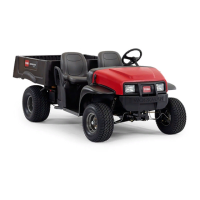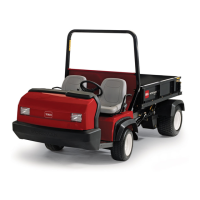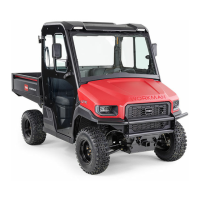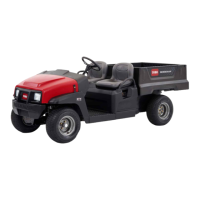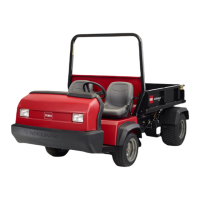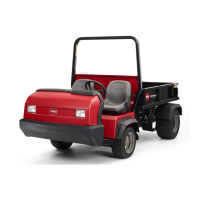18
Checking the Crankcase Oil
The engine is shipped with oil in the crankcase; however,
the level of the oil must be checked before and after the
engine is first started.
1. Position the machine on a level surface.
2. Clean around the oil dipstick (Fig. 11) so dirt cannot fall
into the hole and damage the engine.
1
Figure 11
1. Oil dipstick
3. Remove the oil dipstick and wipe the metal end clean.
4. Slide the oil dipstick fully into the filler tube. Pull the
dipstick out and look at the metal end. If the oil level is
low, add oil of the proper type to raise the level to, but
not over, the “F” mark on the dipstick. Refer to Engine
Oil, page 28, for the proper oil type and viscosity. Add
the oil slowly and check the level often during this
process. Do not overfill.
5. Install the oil dipstick.
Checking the Tire Pressure
Check the tire pressure every 8 hours or daily to ensure
proper levels.
The air pressure range in the front and rear tires is 8–22 psi
(55–103 kPa).
The air pressure needed is determined by the payload
carried. The lower the air pressure, the less the compaction,
smoother the ride, and tire marks are minimized. Lower
pressure should not be used for heavy payloads at high
speeds.
Higher pressures should be used for heavier payloads at
higher speeds. Do not exceed the maximum pressure.
Fuel Tank
Recommended Gasoline
Use fresh, clean, unleaded regular gasoline suitable for
automotive use (87 pump octane minimum). Leaded
gasoline may be used if unleaded regular is not available.
Important Never use gasoline containing methanol,
gasoline containing more than 10% ethanol, gasoline
additives, or white gas because engine fuel system damage
could result.
Danger
In certain conditions, gasoline is extremely
flammable and highly explosive. A fire or
explosion from gasoline can burn you and others
and can damage property.
• Fill the fuel tank outdoors, in an open area,
when the engine is cold. Wipe up any gasoline
that spills.
• Do not fill the fuel tank completely full. Add
gasoline to the fuel tank until the level is 1 in.
(25 mm) below the bottom of the filler neck.
This empty space in the tank allows gasoline to
expand.
• Never smoke when handling gasoline, and stay
away from an open flame or where gasoline
fumes may be ignited by a spark.
• Store gasoline in an approved container and
keep it out of the reach of children. Never buy
more than a 30-day supply of gasoline.
• Always place gasoline containers on the ground
away from your vehicle before filling.
• Do not fill gasoline containers inside a vehicle or
on a truck or trailer bed because interior
carpets or plastic truck bed liners may insulate
the container and slow the loss of any static
charge.
• When practical, remove gas-powered equipment
from the truck or trailer and refuel the
equipment with its wheels on the ground.
• If this is not possible, then refuel such
equipment on a truck or trailer from a portable
container, rather than from a gasoline dispenser
nozzle.
• If a gasoline dispenser nozzle must be used, keep
the nozzle in contact with the rim of the fuel
tank or container opening at all times until
fueling is complete.
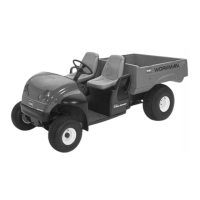
